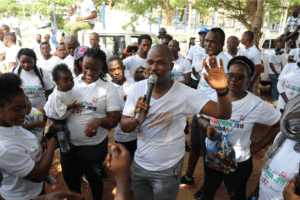
Editors’ note: This piece is from Nonprofit Quarterly Magazine’s winter 2023 issue, “Love as Social Order: How Do We Build a World Based in Love?”
Every gardener—everyone who ever had a yard—knows that when you cut off a weed at its base, it grows back. Below the surface there is a whole root system where the fuel of the plant lives. So it is with our behaviors and our values: our deeply ingrained patterns of behavior are fueled by values deep below the surface. Sometimes, without our conscious awareness, these values driving our patterns of behavior sprout from the seeds of White supremacy, patriarchy, and colonialism. This is true for all of us, dominant and nondominant groups alike. The roots of these systems are alive in each of us—living in our nervous systems and unconsciously driving our perceptions, decisions, and reactions. To root out the ways that oppressive systems live within us, we must attend to deeply entrenched parts of ourselves that are concealed under the surface.
We can’t change individually, as groups or as systems, without changing below the surface.
Another way to say this is that oppressive systems live within us, often without our explicit permission or consent. Any attempt at individual, organizational, or social change that focuses exclusively on external structures without addressing the internal expressions of oppressive systems will achieve only limited or short-term gains. This is because even as we try to change (ourselves, systems, the world), we continue operating in ways that unconsciously align with the values of the very systems we are working to dismantle. The result is mental, emotional, and spiritual depletion; conflict and power struggles within organizations; and structures and systems that look different and yet yield the same outcomes as existing ones.
EI provides a frame for getting to the intricacies of how we either disrupt or perpetuate harmful beliefs and practices individually, interpersonally, organizationally, and systemically.
To lead change at all of these levels in a way that is effective and sustainable, and in a way that allows us to be well in the process, we must do our own internal work and support others to do the same. When we are working and leading within social change organizations, that means building organizational culture and structures that prioritize below-the-surface work.
But how do we get below the surface to see what is not visible to us? In our work training and coaching nonprofit leaders, we have found that an applied framework of emotional intelligence (or EI) provides the internal and interpersonal lenses needed to see and then to shift oppressive patterns within ourselves and our communities. In this article, we operationalize EI in a way that supports dismantling oppressive systems and building liberatory ones by:
- integrating internal work into professional development to improve the way that we manage our own patterns and responses while challenging others directly and with empathy; and
- advocating for and building collective awareness around internal work and personal responsibility as a first step in creating a culture to support the work of social change in a healthy, sustainable, and effective way.
EI provides a frame for getting to the intricacies of how we either disrupt or perpetuate harmful beliefs and practices individually, interpersonally, organizationally, and systemically.
As leadership coaches, we work with leaders and staff in organizations across the country working for social change, and we know firsthand that it is possible to use an EI lens to do this below-the-surface work toward leading more fulfilling and effective work lives.
This isn’t only the work of organizational leaders, however. No matter one’s position within an organization, the skills and approaches we describe support the healing and development of all—both personally and professionally. It is our intention for leaders and staff alike to gain a perspective of better ways, more human ways, for people to come together to work toward common goals. Chronic stress and burnout do not have to be the necessary outcomes of mission-driven social change work; it is possible to be healthy and whole in the process.
Case Study: Deeper Exploration of the Challenge
Nicole is the executive director of an antipoverty-focused nonprofit in a large metropolitan area. Her organization provides services to marginalized communities of color in the city and advocates for universal basic income. The needs of these communities have only increased since COVID, and no matter how hard her team works, they aren’t effectively serving all of their constituents. Knowing that people are suffering and that inequities are growing, the team doubles down and works harder.
At the same time, Nicole’s organization is experiencing unprecedented political backlash. Conservative critique, ever present, has become more extreme and violent in tone. What’s new is that there is a progressive group singling out the organization, accusing it of a paternalistic and White supremacist approach to engaging community stakeholders. Experiencing these critiques from both sides while doubling down on their efforts adds an existential weight to the work.
Meanwhile, the board is pushing to speed up growth and to soften certain messages so as to mollify some specific interest groups, and there are requests and stipulations from funders that feel antithetical to the needs of the community.
In addition to these external challenges, there are internal conflicts among staff and leadership (not including the board) focused on equity. These internal equity battles are diverting resources from the battles the organization is fighting for its stakeholders. While these internal rifts focus mostly on race and gender, there is also a generational divide at play, making challenges even more complicated to make sense of and discuss.
Nicole works 60-plus-hour weeks, and she spends a good deal of that time responding to these challenges. She is experiencing chronic burnout. In this state, she is constantly grappling, both internally and externally, with competing values and commitments. And the ever-increasing urgency of the mission has her experiencing tunnel vision: overprioritizing the most urgent challenges while losing perspective on the big picture.
So, where to begin? People tend to come to us when they are at the end of their rope, like Nicole. They are often seeking a quick technical fix toward being more effective both as individuals and in their organizations. As coaches who work from an EI lens, we invite clients like Nicole to shift their attention for a moment from skills and actions to mindsets and emotions—because what they seek to change requires new mindsets and behaviors, and new mindsets are the unseen roots required to establish new behaviors.
When we look below the surface, we can recognize the ways in which oppressive patterns live within us. In doing so, we reprogram our brains to recognize limiting patterns of thought and behavior.
Our invitation to mindset and emotion work is often met with resistance: “I don’t have time for that. I have real work to do. Just tell me what I need to do to deal with all these challenges.” Embedded in such responses are internal obstacles we have come to recognize as cycles of urgency that can lead to tunnel vision. The challenges of mission-driven work are urgent, but operating only in urgency disempowers us and robs us of our locus of control. Urgency can also lead to unconsciously falling into default values that are in alignment with an oppressive system: an overemphasis on urgency, productivity, and results causes us to live into values connected to White cultural norms and colonization. Ironically, we find ourselves working by the rules—the values—of oppressive systems we are fighting to dismantle. When our focus is consumed by just the immediate problem, this can cause us to lose sight of our larger mission and vision and to make choices out of alignment with our true values. Our decisions can become less inclusive, less equitable, less collaborative. The end result, when urgency causes us to be out of balance, will tend to be a reduction in creativity when working and problem-solving; erasure of the necessary human elements of joy, rest, and balance; and real harm to each other and ourselves in the process.
Start with Self-Awareness
When we look below the surface, we can recognize the ways in which oppressive patterns live within us. In doing so, we reprogram our brains to recognize limiting patterns of thought and behavior and build new internal strategies to create new patterns. We get to the roots of our internal obstacles and can intentionally plant new seeds to live in alignment with our true values.
To understand how you may be getting stuck in competing commitments, you must build deeper awareness about your emotions and the stories you tell yourself in key choice moments.
This process starts with building awareness of the tensions at our core—which, with mission-driven work, often revolve around our values. When we get stuck or lost in mission-driven work, there are typically two or more values at war inside us. In their 2001 article “The Real Reason People Won’t Change,” Robert Kegan and Lisa Laskow Lahey call this values tension “competing commitments,”1 whereby people experience tension between a value at the existential level and a value at the day-to-day organizational work level. In these moments, our mission, our stakeholders’ needs, and our personal needs are often competing for primacy. The fundamental question to consider when this happens is: When does operating from a value take us out of alignment with our mission and our humanity? We can only answer that question if we are aware of our competing values in the moment. The following exercise helps to get to the answer:
- Ask yourself, “Why have I chosen to do this work?” Make a list of core values that answer that question. Then ask yourself, “Why do I care about personal sustainability?” Make a list of values that answer that question. In these two lists, you will likely find many competing commitments.
- Now, ask yourself a question having to do with a competing value, such as, “Why do I care about satisfying our board and our funders?” Make a list of values that answer this question.
- Notice the tension in this soup of values that you likely contend with daily.
Put Competing Commitments in Context
To understand how you may be getting stuck in competing commitments, you must build deeper awareness about your emotions and the stories you tell yourself in key choice moments that lead you to default to oppressive values. Think for a moment about a recent decision or efforts that did not result in the outcomes you wanted (for yourself and/or your organization). Now, think back to when you chose this course of action. It is likely that something happened that triggered an emotional reaction in you, compelling you to make a choice in tension with your true values in this context. Be as clear as you can about the specific trigger moment; then, think more broadly about how that trigger may show up regularly for you.
For example, when Nicole receives hateful emails from critics, or long equity-complaint emails from staff members cc’ing the rest of the staff, she notices numbness in her forehead, heat on the back of her neck, and shallow breathing. In these micromoments, Nicole is experiencing a chain reaction that starts in the body. Because we process stress physiologically before we process it emotionally or intellectually, our bodies are our early warning system. Where do you feel your reaction in your body when you are triggered? These internal body sensations—known as interoception—go unnoticed when we are unconscious of or find it difficult to respond to signals from our bodies that something does not feel okay.2 And yet, these interoceptive sensations are unconsciously driving our behaviors as the first catalyst in this chain reaction.
Sign up for our free newsletters
Subscribe to NPQ's newsletters to have our top stories delivered directly to your inbox.
By signing up, you agree to our privacy policy and terms of use, and to receive messages from NPQ and our partners.
Our physical reactions and sensations are interpreted as emotion. In such activated moments, we tend to experience a complex mix of emotions that focus inward as well as outward and that likely range from mild to very negative. Our emotions then lead to stories we tell ourselves about ourselves, about others, and about the world that do not serve us.
In their work on competing commitments, Kegan and Lahey focus on fear in this moment of being triggered. When someone is stuck in a pattern of behavior that they want to change, the authors suggest that the person ask themself what they are afraid will happen if they make the change.3 One response of Nicole’s might be, “If I do prioritize self-care, then my colleagues will see me as selfish.” This is an example of a self-limiting story. Make a list of the self-limiting stories that come up for you. Consider how these stories shed light on how your values can become your obstacles.
Your self-limiting stories and behaviors serve you by protecting you from the fears that you just surfaced. While this may seem illogical, consider how some of your choices might be making you feel good in the short term. Consider how jumping into reactive challenges, doing work outside of your role, or even retreating to your office to answer email might have a short-term positive effect. As you consider this, try to write down the stories you tell yourself in the moment (I’m saving the day! I’m getting to inbox zero!) that connect with those emotions. What are you telling yourself in the moment that makes you feel effective or affirmed? What stories are you telling yourself about being a leader or a change agent? Being aware of how these positive emotions and stories serve you and how they do not plays an important role in shifting your patterns.
The deeper our stories, the more connected they are to our identities. For those growing up in America, our 400-year history of White male supremacy makes it inevitable that racism and sexism will impact our mindsets and behaviors. Tema Okun writes about common internal or shared stories grounded in White culture that become cultural norms for everyone.4 Two that we observe among those doing mission-driven work are:
- a focus on urgency—valuing fast, highly visible results as more important than building collaboration, allies, and the interests of communities; and
- a focus on quantity over quality—valuing and directing resources to what can be measured while devaluing things that are hard to measure, like process and relationships.
The stronger and more exclusive the dominant culture is in your organization, the more likely it becomes that these stories and norms will manifest themselves. Consider how the above White cultural norms and other narratives of privilege or oppression may be in play for you.
Self-management in our leadership practice is about derailing the chain reaction of ineffective habits at the level of emotion and stories so that we can choose new behaviors.
Use Self-Management to Interrupt Default Patterns
We cannot stop our triggers and our initial interoceptive reactions—they are hardwired. However, we can manage triggers and emotions once we become aware of them. More important, we can choose the stories we tell ourselves in response to our emotional reactions. Self-management in our leadership practice is about derailing the chain reaction of ineffective habits at the level of emotion and stories so that we can choose new behaviors. And as we practice choosing new behaviors, we are building new patterns—starting the process of reprogramming ourselves so as to weaken the impact of oppressive values and so that we can act in alignment with our liberatory values.
Creating a few seconds of space between our triggers and what we actually do is a prerequisite for accessing other in-the-moment strategies. This pause is the strategy that interrupts the cycle. It creates space for us to slow down and think. What can you do to create space between your triggers and your actions? Do you already have meditative practices in your life, such as yoga, prayer, or mindfulness? If you do, you probably already have breathing strategies. A couple of deep breaths over a matter of seconds can be all you need to regain your ability to think clearly. There may be other micromovements that you already do with your body that calm you down (taking a sip of water, shifting your posture). How might you more intentionally do those things during your moments of choice?
Once we have slowed down and returned to our thinking brain, we can access our “inner coach.” This is when we can choose which values to activate. Effective self-coaching helps us to choose our aligned values and not our unconscious defaults in the challenging moment. Consider the values you listed earlier in the exercise. Now, take yourself back to the trigger moments/competing values. Ask yourself which of the values you identified will best serve you when you are triggered and in danger of defaulting to oppressive values. Choose one or two. Now, consider how these values can orient you to your true north at this moment. Up to this point, you have had a sort of “anti-coach” on your shoulder whispering stories and advice that have mostly held you back in such moments. Imagine a new coach—your “inner coach”—on your other shoulder. What can this new coach tell you that will be more powerful than your anti-coach’s self-limiting stories? Create brief phrases your new inner coach can bring to the moment. Write up to three of these and put them somewhere you will see them regularly, such as on a wall or mirror. Some examples from people we have coached include the following:
- The work will never be done. It’s okay to take time to care for myself.
- Being direct and challenging others is an expression of love and care.
- I am in acceptance; people are where they are, and things are uncertain. I’m okay with that.
- What is in service of justice and liberation in this situation?
Now, think about your identities. We all have intersecting identities (gender, ethnicity, race, age, religion, etc.) that impact the way we see and experience the world. Reread the first two lists of values from the first exercise and the inner-coach statements you just generated. Consider how your identities connect with and inform these lists and statements. Then, consider how intentional anchoring in your identities can empower you to shift your habits. Weave your identity narratives into the inner-coach statements you just wrote.
To change yourself, you will also have to manage change with others. Fortunately, in doing so you will help others grow, help shift culture, and help dismantle oppressive structures.
Our challenging moments—those when we feel triggered or activated emotionally—hold the greatest potential for us to change our patterns and create new ones. These critical moments invite us to build greater self-awareness. That means connecting with our bodies and noticing physical sensations, becoming aware of our emotions, and being mindful of our thoughts and stories—and how they are driven by oppressive values and how they are driven by liberatory ones. Building self-awareness in this way gives us agency to come off of autopilot and choose how we want to respond. This is where self-management comes in: we can use specific strategies to interrupt and manage our automatic perceptions, reactions, and behaviors (some of which have been outlined earlier). The key components are slowing down, creating space, and enabling empowering self-talk by activating one’s inner coach.
Advocate to Build a Culture That Prioritizes Internal Work
While working on one’s self can be empowering and transformative, it’s still only part of the solution. You can’t change your personal habits in a vacuum. One’s habits are inextricably linked to other people, cultures, and structures—and mission-driven organizations tend to encourage or implicitly expect some of the behaviors you may be trying to change. These organizational forces may be invisible to you until you start looking for them—so making personal changes will require you to diagnose and engage obstacles connected to individuals, teams, and even systems along the way. To change yourself, you will also have to manage change with others. Fortunately, in doing so you will help others grow, help shift culture, and help dismantle oppressive structures.
In the language of EI, advocating for change requires strong social awareness and relationship management. When coaching people to influence others on these below-the-surface issues, we operationalize social awareness and relationship management via three big questions:
- Where are those whom I wish to engage? This question supports gaining perspective on the beliefs, emotions, and interests of those you intend to engage vis-à-vis your work. In our case (as leadership coaches), we consider where others are in their awareness (of us, themselves, the team culture) and motivation to support change (yours, theirs, and/or the group’s/team’s). This question should be applied to individuals (peers, direct reports, managers), groups (functional teams), and the organization (senior leaders, the board, the organization as a whole) as you engage over time.
- Where do I want them to be? This question supports intentional thinking about targets: the intended outcomes, or changes, you hope to accomplish through your engagement with others. These targets should focus on the behaviors, mindsets, and relational conditions that you want to shift. Targets that come up in coaching include managing up to create stronger personal boundaries and to advocate for shifts in structures and culture; raising individual and group awareness about mindsets, behaviors, and their impact; and supporting people individually to work on their own competing values and behaviors.
- What do they need from me to get there? This question supports strategic thinking about how to engage. Note that this question comes after having gained perspective and identified targets. In our leadership coaching practice, we refer to this phase as the EI dimension of relationship management. In the following section, we describe three tactics that support clients in thinking through their strategy: connection, care, and challenge. In every effective human engagement, these three elements are present. When we practice strong relationship management, we deliberately choose the right balance of these elements to meet our goals. These choices are inherently adaptive, as we respond to the needs of the person/group and context in the moment.
Promote Connection, Care, and Challenge
The first essential element is connection. Connection is about attunement—truly knowing where each other is in the moment. We emphasize authenticity here over harmony (connection does not always feel good, but it must feel real).
We offer the following as behaviors promoting true connection:
-
- Vulnerability—showing up as you, the human being who is working on these issues; sharing your story to make it safe for others to share theirs.
- Listening—confirming or revising your diagnosis about “where they are”; listening requires curiosity, asking questions, and responding personally to what we hear.
- Finding common values—both grounding in our common power and raising awareness about competing commitments.
The second essential element is care. Consider how you can bring genuine care to the conversation. We offer the following as care anchors in this context:
-
- Affirming others’ fears and competing commitments while also naming that those fears and values might be getting in their way.
- Expressing belief and hope in growth potential and commitment to shared values.
- Showing investment in them, the organization, and your relationship.
The third essential element is challenge. Change will never happen without challenging ourselves to make shifts. We ask the following questions when coaching clients, to deliberately challenge competing values:
-
- How can you call out the competing commitments at the heart of a challenge to surface fears and address them?
- How can you challenge others’ stories that underplay or omit the negative impact of current behaviors and mindsets?
- How can you push the conversation beyond short-term impact and outcomes to consider long-term impact and outcomes when analyzing current practices, structures, and culture?
- How can you name this short-term versus long-term tension as an equity issue connected to White cultural norms as described earlier?
We are most likely to achieve our targets when we effectively lean into care and challenge—at the same time—to stay connected.
***
We have seen so many mission-driven nonprofits stuck in a cycle of cutting weeds at the surface and watching them grow back—reacting to the latest challenge with the quickest fix or tactical shift, and getting the same results. We feel deep compassion for them, because we see how hard the work is—and it’s only getting harder. We also see that there can be a different way. We have helped people create the space to go below the surface and become aware of their competing values, limiting stories, and unuseful behaviors. This new awareness, coupled with deliberate internal strategy building, allows them to interrupt patterns deep within and disrupt the ways that oppressive systems have lived within them and driven their behavior. When people feel empowered and liberated, they are more moved to engage in internal work with their teams. Collectively—and from the inside out—they create a different way to do mission-driven work: one that yields better results and feels sustainable. When we slow down and create real space to do below-the-surface work—to get to the roots—we can find this way together.
Notes
- Robert Kegan and Lisa Laskow Lahey, “The Real Reason People Won’t Change,” HBR OnPoint, no. 8121 (November 2001): 85–92.
- For more on interoception, see for example A. D. (Bud) Craig, How Do You Feel?: An Interoceptive Moment with Your Neurobiological Self (Princeton, NJ: Princeton University Press, 2014).
- Kegan and Lahey, “The Real Reason People Won’t Change,” 88.
- Tema Okun, “White Supremacy Culture,” Dismantling Racism Works Web Workbook, accessed October 15, 2023, www.dismantlingracism.org/white-supremacy-culture.html.








